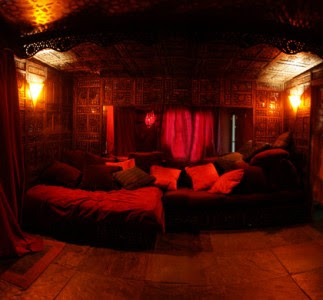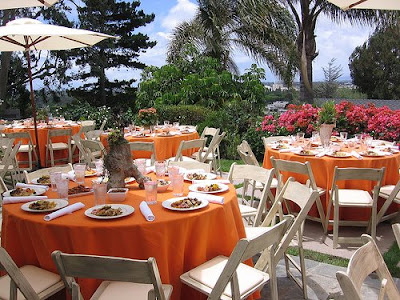
I touched on the Marrakesh House in Friday's post. Here's the skinny on the newest green venue for events and weddings. Located in Culver City, adjacent to California's newest state park, this 4,300 square foot venue blends artistic expression and environmental values.
I have many Morrocan items in my house and I wish I could put it all together the way interior designer Charlotte Jackson has. The tea temple is the perfect place to hold your ceremony with your guests seated around the pool and lawn. You may also choose to have cocktail hour or dinner around the pool.


What makes this space green?
Exterior
- The landscaping utilized permaculture techniques. The plants used need little water, are native, or are edible trees and bushes. By trimming a neighbor’s overgrown cactus and replanting the trimmings along the edge of the house, plant life was rescued and introduced an additional plant that does not require water.
- Existing trees were pruned and the pruned branches were used to created fences around the property.
- Low-flow irrigation is used outside to water the edible and native plants that require water.
- The retaining walls around the property are all made from waste materials from other construction sites around the city. No new materials were purchased for the retaining walls.
- Cement path walkway blocks were reused, rather than pouring new walkways.
- Reclaimed barn wood was used for gates and privacy partitions around the property.
- The organic living food garden is a three season garden with a variety of edible plants. The wood used to create the planters in the garden uses non-treated lumber from Trex and post-consumer milk crates.
- A two panel solar thermal array heats enough water for four people on average. The hot water tank is 97% energy efficient stainless steel. An on-demand hot water heater is used in the kitchen. No other gas or electric water heaters are used in the house.
- The photovoltaic (solar) system on the roof produces enough energy, about 30 kwh a day and 11,000 kwh a year, to supply approximately 60% of the house’s electricity.
Interior
- All the wood used in the house is FSC certified (Forest Stewardship Council).
- None of the paint used contains VOC (Volatile Organic Compounds).
- The cabinets in the kitchen and bar are made of FSC formaldehyde-free bamboo. Bamboo is a rapidly renewable product that grows to maturity within 7-10 years.
- All insulation is fiber glass BATTS, a silicon-based formaldehyde-free material and only formaldehyde-free drywall paper was used.
- The lighting in the house uses a low-tech approach incorporating high-efficacy (provide more light with less energy) lighting by using compact florescent (CFL), cold cathode fluorescent (CCFL), tubular fluorescent (T5), IR halogen MR16s (IR MR16s), and light emitting diode (LED) lights.
- Lighting controls (dimmers and motion sensors) save electricity, make lamps (light bulbs) last longer, and turn them off when not needed.
- Toilets in the house are low-flow to reduce water consumption.
- The original kitchen cabinets were recycled into new bathroom cabinets.
- Stone floors were laid because they will last for thousands of years.
- Three electric vehicle charging systems were installed in the garage

No comments:
Post a Comment